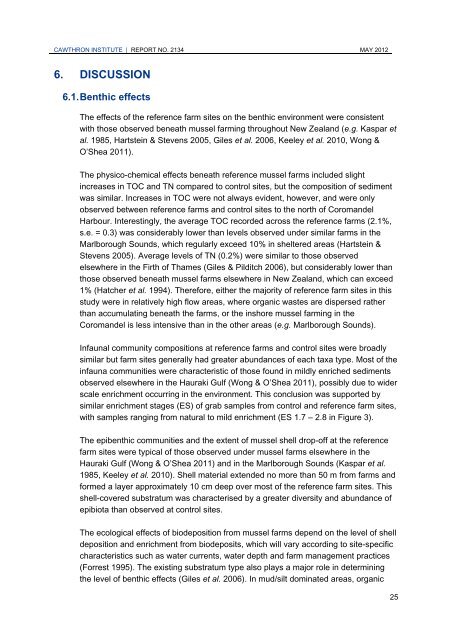Application 124771 - Ministry of Fisheries
Application 124771 - Ministry of Fisheries
Application 124771 - Ministry of Fisheries
You also want an ePaper? Increase the reach of your titles
YUMPU automatically turns print PDFs into web optimized ePapers that Google loves.
CAWTHRON INSTITUTE | REPORT NO. 2134 MAY 2012<br />
6. DISCUSSION<br />
6.1. Benthic effects<br />
The effects <strong>of</strong> the reference farm sites on the benthic environment were consistent<br />
with those observed beneath mussel farming throughout New Zealand (e.g. Kaspar et<br />
al. 1985, Hartstein & Stevens 2005, Giles et al. 2006, Keeley et al. 2010, Wong &<br />
O’Shea 2011).<br />
The physico-chemical effects beneath reference mussel farms included slight<br />
increases in TOC and TN compared to control sites, but the composition <strong>of</strong> sediment<br />
was similar. Increases in TOC were not always evident, however, and were only<br />
observed between reference farms and control sites to the north <strong>of</strong> Coromandel<br />
Harbour. Interestingly, the average TOC recorded across the reference farms (2.1%,<br />
s.e. = 0.3) was considerably lower than levels observed under similar farms in the<br />
Marlborough Sounds, which regularly exceed 10% in sheltered areas (Hartstein &<br />
Stevens 2005). Average levels <strong>of</strong> TN (0.2%) were similar to those observed<br />
elsewhere in the Firth <strong>of</strong> Thames (Giles & Pilditch 2006), but considerably lower than<br />
those observed beneath mussel farms elsewhere in New Zealand, which can exceed<br />
1% (Hatcher et al. 1994). Therefore, either the majority <strong>of</strong> reference farm sites in this<br />
study were in relatively high flow areas, where organic wastes are dispersed rather<br />
than accumulating beneath the farms, or the inshore mussel farming in the<br />
Coromandel is less intensive than in the other areas (e.g. Marlborough Sounds).<br />
Infaunal community compositions at reference farms and control sites were broadly<br />
similar but farm sites generally had greater abundances <strong>of</strong> each taxa type. Most <strong>of</strong> the<br />
infauna communities were characteristic <strong>of</strong> those found in mildly enriched sediments<br />
observed elsewhere in the Hauraki Gulf (Wong & O’Shea 2011), possibly due to wider<br />
scale enrichment occurring in the environment. This conclusion was supported by<br />
similar enrichment stages (ES) <strong>of</strong> grab samples from control and reference farm sites,<br />
with samples ranging from natural to mild enrichment (ES 1.7 – 2.8 in Figure 3).<br />
The epibenthic communities and the extent <strong>of</strong> mussel shell drop-<strong>of</strong>f at the reference<br />
farm sites were typical <strong>of</strong> those observed under mussel farms elsewhere in the<br />
Hauraki Gulf (Wong & O’Shea 2011) and in the Marlborough Sounds (Kaspar et al.<br />
1985, Keeley et al. 2010). Shell material extended no more than 50 m from farms and<br />
formed a layer approximately 10 cm deep over most <strong>of</strong> the reference farm sites. This<br />
shell-covered substratum was characterised by a greater diversity and abundance <strong>of</strong><br />
epibiota than observed at control sites.<br />
The ecological effects <strong>of</strong> biodeposition from mussel farms depend on the level <strong>of</strong> shell<br />
deposition and enrichment from biodeposits, which will vary according to site-specific<br />
characteristics such as water currents, water depth and farm management practices<br />
(Forrest 1995). The existing substratum type also plays a major role in determining<br />
the level <strong>of</strong> benthic effects (Giles et al. 2006). In mud/silt dominated areas, organic<br />
25
















